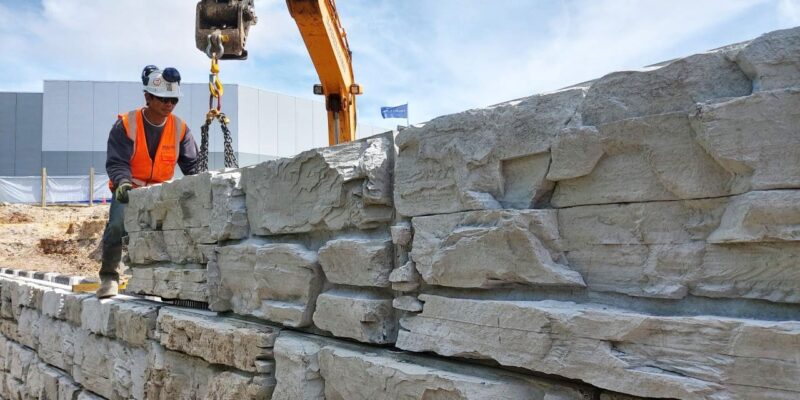
Retaining walls are solid wall constructions that hold soil lateral to maintain the ground surface at different elevations on both sides. The main purposes of retaining wall engineering are to stabilize the soil and create protected landscapes. This type of landscaping wall is usually built from rocks, concrete blocks, or other materials. These walls are integrated with the property’s landscape to maximize the property’s value while adding an aesthetic touch.
Retaining Wall
Retaining walls are built to withstand soil pressure in a ground elevation. It is designed to keep the soil or other materials vertical or almost vertical. Retaining walls are usually seen in engineering for roads, railroads, bridges, irrigation systems, land reclamation, and coastal structures. The base block (usually 6 meters) is monolithically attached to the vertical or slope stem.
The advantages of these walls are-
- Protective Architecture
- Steady performance
- Best run-off strategy
- Minimal maintenance
- Decorative feature
- Collapsible wall designs
Retaining Wall Purpose
- This wall stops soil or other materials from sliding when an unexpected elevation change takes place.
- Earth-retaining structures hold the soil in place and sustain the gap in ground-surface height.
- Retaining structures are made to outlast the soils or backfill to deliver externally imposed forces to a foundation.
Retaining wall engineering
Identifying and resisting the tendency of the retained material to fall downwards due to gravity is the most vital aspect of the efficient design and installation of a retaining wall. These walls are used to hold soil laterally in order for it to be held at varying scales on both sides.
To reduce strain on the wall’s set point, proper drainage below the wall is important. Drainage material will significantly minimize hydrostatic pressure and increase the material behind the wall’s stability.
Retaining wall engineering is specifically done to interconnect soils between two different elevations in parts of terrain with unsuitable slopes or in areas where the terrain must be reshaped forcefully and sculpted for more specific purposes, such as hillside farming or freeway overpasses.
Types of retaining walls
1. Gravity wall
In order to resist tension from behind, gravity walls depend on their mass. They may also feature a batter setback, which bends down toward the trapped soil to add stability. They are usually built of mortarless rock and split precast units. Gravity walls that are dry-stacked have the flexibility and don’t require a hard base.
2. Concrete cantilever wall
This is attached to the foundation and rebuffs a slab foundation. The load of the backfill and surcharge effectively stabilizes the structure against overtaking and scooting.
3. Buttressed wall
These are cantilever walls that are straightened with block forts that are monolithic with the wall slab and base slab. In order to reduce the bending moment in curved sides of great height, the counterfort serves as a tension flexural reinforcement and links the wall slab and the base.
4. Reinforced soil wall
These are built with steel or geotextile soil reinforcement in a layer within a constrained granular fill.
5. Green wall
These are used to keep mild slopes in place. For the purpose of stabilizing the slope’s surface, these walls are made in a Geo cellular structure, such as a grid of honeycomb cells.
6. Mechanical stabilization wall
These can withstand significant lateral movement. In order to keep the backfill dirt in place, the wall face is filled with granular soil. The benefit of MSE walls is that they don’t need a framework.
7. Anchored wall
An anchored retaining wall is reinforced with cables or other fixtures that are fixed in the soil or rock. It is usually bored into the material, and anchors are inflated at the end of the cable, either mechanically or by injecting pressure concrete, which creates a bulb on the surface.
Conclusion
Apart from serving the aesthetic purpose, Retaining wall engineering significantly contributes to a project’s structural strength. It provides protection against soil erosion or flooding and prevents structural failure by giving commercial buildings solid foundational support in the elevated regions.











